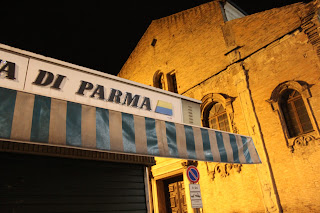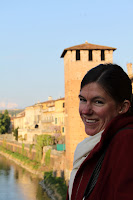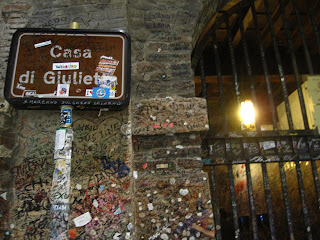Initially, Verona was mostly a sleep stop. Our eyes were set on seeing Sirmione, and catching half a day or so of Verona before or after. Of course, it is always those short term places that end up being the most desired long term places on one's visit.
I will admit, Romeo and Juliet was not an attraction to the city, but rather an adherence. I assumed the town to be crawling with Romeo and Juliet souvenirs, gagdets, and syrupy photo shots. Okay so there was some hot and heavy tourist grabbing going on (as you can tell form the pictures), but I was actually taken aback by Verona. The beauty of the city itself pushed fictional spot of Shakespeare's play into the backstage. There is a reason Shakespeare chose Verona as the site for his romantic tragedy.
Verona's Roman history lends itself to a beautiful melange of architecture. The walls surrounding the old city center, just across the bridge, remain a mix of Roman, medieval, and post medieval construction (though the majority is medieval). Coincidentally we walked over the famous medieval bridge just at sunset. The sun accentuated the heavy red brick and stoic imposing architecture as we crossed. It was hard to imagine a better times visit.
Once across the medieval bridge and into the old city center, one immediately finds themselves walking down curved cobblestone streets, with buildings following the curved paths. Every now and then, and ancient Roman archway or medieval structure jolts out of the Venetian colored and crafted buildings, providing a beautiful juxtaposition against the surrounding green hills. Coming from Paris, where buildings all come in one shade or another of gray, no matter how much opulence, Verona is a refreshing surprise.
We continued meandering down cobblestone streets making our way to the Coloseum. Like the Trevi Fountain in Rome, the Colosseum comes out of nowhere, opening up onto a colorful plaza lined with cafes and colorful buildings. That particular weekend, plaza shared its space with a regional food festival, with 30 stalls selling artisanal Italian products. Yum. Hungry for dinner, we couldn't help but sample some of the delicious foods, and take some salivating pictures as well.








The most surprising part, being in the north, was the affordable price of food. Eating cheap in Northern Italy can be challenging. Verona provided surprisinglly good food for decent prices. Our dinner that night was as local as it gets. We received a recommendation from our Air BnB host, explaining the place as the local place. When we arrived, those working there looked at us as if we were from another planet, needing guidance as to where real Verona lay. Through four year old Italian, we explained our need for dinner, after which we were shooed into a small table in the corner. The only slightly English speaking waiter joined us immediately, quickly detailing the menu for the day. We selected the pastas, entrees, and a glass of wine. H returned, bruskly placing a carafe of water and a full bottle of wine. Looked like it was going to be an interesting night. An hour later, and an almost empty bottle, we received our bill for two pastas, a bottle of wine and two entrees. Nervous, we opened the paper: 30 euros! For two people. The wine turned out to be 2 euros for the bottle. Guess there really was no way to order anything smaller.




The rest of the night, and the rest of the following morning entailed further meandering down car-less quiet intimate streets. Verona is a large city with a feel of a small town. The only difference? Eye candy, things to do, and a lively night life. As romantic as meandering the maze-ladden streets of Venice, yet as readable and logical as the classic American cities, Verona was a city hard to leave. Wait, so how does the city manage this conundrum? Vistas, small city center, and numerous landmarks.























































